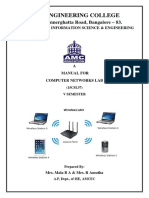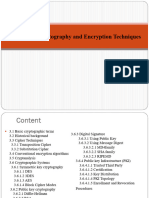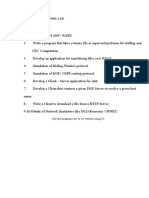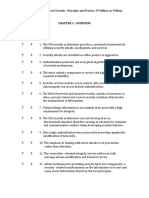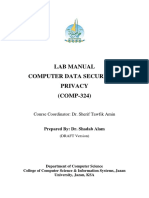Chapter 3 - Program Security
Uploaded by
Robbinson MamtafChapter 3 - Program Security
Uploaded by
Robbinson MamtafSecurity in Computing, 4th Ed, Pfleeger
Chapter 3
Program Security
By Mohammed Al-Saleh / JUST
Chapter 3
In this chapter
Programming errors with security implications
Malicious code
viruses, worms, Trojan horses
Program development controls against malicious
code and vulnerabilities
buffer overflows, incomplete access control
software engineering principles and practices
Controls to protect against program flaws in
execution
operating system support and administrative controls
By Mohammed Al-Saleh / JUST
Protecting programs is at the heart of computer
security
Chapter 3
Programs Security
programs constitute so much of a computing system
(the operating system, device drivers, the network
infrastructure, database management systems and
other applications, even executable commands on
web pages); all are called programs
So we need to ask two important questions:
How do we keep programs free from flaws?
How do we protect computing resources against
programs that contain flaws?
By Mohammed Al-Saleh / JUST
Chapter 3
Secure Programs
What we mean when we say that a program is
"secure."
security implies some degree of trust that the program
enforces expected confidentiality, integrity, and
availability.
From the point of view of a program or a
programmer, how can we look at a software
component or code fragment and assess its
security?
similar to the problem of assessing software quality in
general
By Mohammed Al-Saleh / JUST
Chapter 3
Secure Programs
One way to assess security or quality is to ask
people to name the characteristics of software
that contribute to its overall security
different answers from different people because the
importance of the characteristics depends on who is
analyzing the software
By Mohammed Al-Saleh / JUST
one person may decide that code is secure because it takes
too long to break through its security controls
someone else may decide code is secure if it has run for a
period of time with no apparent failures
a third person may decide that any potential fault in meeting
security requirements makes code insecure
Chapter 3
Secure Programs
An assessment of security can also be influenced by
someone's general perspective on software quality
if your manager's idea of quality is conformance to specifications,
then she might consider the code secure if it meets security
requirements, whether or not the requirements are complete or
correct.
This security view played a role when a major computer
manufacturer delivered all its machines with keyed locks
since a keyed lock was written in the requirements
But the machines were not secure, because all locks were configured to use
the same key
Thus, another view of security is fitness for purpose
By Mohammed Al-Saleh / JUST
in this view, the manufacturer (mentioned above) clearly had room for
improvement
Chapter 3
Secure Programs
In general, practitioners often look at quantity
and types of faults for evidence of a product's
quality (or lack of it)
developers track the number of faults found in
requirements, design, and code inspections and use
them as indicators of the likely quality of the final
product
By Mohammed Al-Saleh / JUST
Chapter 3
Fixing Faults
You might argue that a module in which 100
faults were discovered and fixed is better than
another in which only 20 faults were discovered
and fixed
more rigorous analysis and testing had led to the
finding of the larger number of faults
By Mohammed Al-Saleh / JUST
Chapter 3
Fixing Faults
Early work in computer security was based on the
paradigm of "penetrate and patch,"
analysts searched for and repaired faults
test a system's security by attempting to cause it to
fail
The test was considered to be a "proof" of security
if the system withstood the attacks, it was considered secure
Unfortunately, the proof became a counterexample
The problem discovery in turn led to a rapid effort to
"patch" the system to repair or restore the security
By Mohammed Al-Saleh / JUST
However, the patch efforts were largely useless, making the
system less secure rather than more secure because they
frequently introduced new faults
9
Chapter 3
Read about Fuzz Testing
By Mohammed Al-Saleh / JUST
10
Chapter 3
Unexpected Behavior
A better approach than "penetrate and patch," is to
compare the requirements with the behavior
Test whether programs behave as their designers intended or
users expected
unexpected behavior is a program security flaw
Program security flaws can derive from any kind of software
fault
two separate logical categories of program flaws :
Inadvertent/unintentional human errors
malicious, intentionally induced flaws.
we still have to address the flaws effects, regardless of
intention.
By Mohammed Al-Saleh / JUST
They range from a misunderstanding of program requirements to a onecharacter error in coding or even typing
"it doesn't matter whether the stone hits the pitcher or the pitcher hits the
stone, it's going to be bad for the pitcher."
11
Chapter 3
Security Flaws
A system attack often exploits an unintentional security
flaw to perform intentional damage
Regrettably, we do not have techniques to eliminate or
address all program security flaws
security is fundamentally hard and conflicts with usefulness and
performance
Two reasons for this distressing situation
To test a program functionality we test against the should do checklist NOT
the should not do one. It is almost impossible to ensure that a program
does precisely what its designer or user intended, and nothing more.
Programming and software engineering techniques change and evolve far
more rapidly than do computer security techniques
By Mohammed Al-Saleh / JUST
So we often find ourselves trying to secure last year's technology while software developers are
rapidly adopting today's and next year's technology.
12
Chapter 3
Types of Flaws
A list of categories that helps distinguishing one kind of
problem from another and gives us a useful overview of
the ways in which programs can fail to meet their security
requirements
Validation error (incomplete or inconsistent): permission checks
occur when a program fails to check that the parameters
supplied or returned to it conform to its assumptions about
them, or when these checks are misplaced
Domain error: controlled access to data
occur when the intended boundaries between protection
environments are porous including implicit sharing of
privileged/confidential data or when then the lower level
representation of an abstract object, supposed to be hidden
in the current domain, is in fact exposed
By Mohammed Al-Saleh / JUST
13
Chapter 3
Types of Flaws
Serialization: program flow order
Boundary condition violation: failure on first or last case
permit asynchronous behavior of different system components to
be exploited (TOCTTOU)
occur due to omission of checks to assure that constraints (table
size, file allocation, or other resource consumption) are not
exceeded
Inadequate identification and authentication: basis for
authorization
permits operations to be invoked without sufficiently checking the
identity and the authority of the invoking entity
By Mohammed Al-Saleh / JUST
14
Chapter 3
Nonmalicious Program Errors
Unintentional mistakes
cause program malfunctions
but some lead to more serious security vulnerabilities
By Mohammed Al-Saleh / JUST
15
Chapter 3
Buffer Overflows
It is an example on Boundary condition violation
Definition
A buffer (or array or string) is a space in which data
can be held
A buffer resides in memory
Because memory is finite, a buffer's capacity is finite
in many programming languages the programmer
must declare the buffer's maximum size
By Mohammed Al-Saleh / JUST
Then the compiler can set aside that amount of space
16
Chapter 3
Buffer Overflows
Example
char sample[10];
One byte for elements sample[0] through sample[9]
Now we execute the statement:
sample[10] = 'B';
The subscript 10 is out of bounds
The compiler can detect it during the compilation
However, if the statement were
By Mohammed Al-Saleh / JUST
sample[i] = 'B';
we could not identify the problem until i was set during execution
The problem's occurrence depends on what is adjacent to the
array sample
17
Chapter 3
Buffer Overflows
Example
suppose each of the ten elements of the array sample
is filled with the letter A and the erroneous reference
uses the letter B, as follows:
for (i=0; i<=9; i++)
sample[i] = 'A';
sample[10] = 'B'
By Mohammed Al-Saleh / JUST
18
Chapter 3
Buffer Overflows (Example Cont.)
So there are four cases to consider in deciding where
the 'B' goes
By Mohammed Al-Saleh / JUST
19
Chapter 3
Buffer Overflows (Example Cont.)
If the extra character overflows into the user's data space
it simply overwrites an existing variable value
perhaps affecting the program's result
but affecting no other program or data
In the second case, the 'B' goes into the user's program
area
If it overlays an already executed instruction
no effect
If it overlays an instruction that is not yet executed
the machine will try to execute an instruction with operation code 0x42
the internal code for the character 'B
Spilling over into system data or code areas produces
similar results to those for the user's space: computing with
a faulty value or trying to execute an improper operation.
By Mohammed Al-Saleh / JUST
20
By Mohammed Al-Saleh / JUST
Chapter 3
Process Address Space
21
By Mohammed Al-Saleh / JUST
Chapter 3
Call Stack / Activation Record
22
Chapter 3
Integer Overflow
http://www.phrack.org/issues.html?issue=60&id=10
Since an integer is a fixed size (32 bits for the purposes of this
paper), there is a fixed maximum value it can store. When an
attempt is made to store a value greater than this maximum value it
is known as an integer overflow.
Most compilers seem to ignore the overflow, resulting in an
unexpected or erroneous result being stored.
This can get dangerous if the calculation has to do with the size of a
buffer or how far into an array to index.
What happens then!!
a = 0xffffffff
b = 0x1
r = a + b r = (0xffffffff + 0x1) % 0x100000000
r = (0x100000000) % 0x100000000 = 0
This is often called a "wrap around", as the result appears to wrap around to 0.
By Mohammed Al-Saleh / JUST
23
Example 1
#include <stdio.h>
int main(void){
unsigned int num = 0xffffffff;
printf("num = %u (0x%x)\n", num, num);
printf("num + 1 = 0x%x\n", num + 1);
return 0;
}
/* EOF */
The output of this program looks like
this:
num = 4294967295 (0xffffffff)
num + 1 = 0x0
By Mohammed Al-Saleh / JUST
Chapter 3
Integer Overflow Examples
Example 2
#include <stdio.h>
int main(void){
int n;
n = 0x7fffffff;
printf(n = %d (0x%x)\n", n, n);
printf(n + 1 = %d (0x%x)\n", n + 1 , n + 1);
return 0;
}
/* EOF */
The output of which is:
n = 2147483647 (0x7fffffff)
n + 1 = -2147483648 (0x80000000)
24
Chapter 3
Incomplete Mediation (ex. SQL Injection)
John Fiore
SELECT * from CUSTOMERS
WHERE name = 'John Fiore'
By Mohammed Al-Saleh / JUST
25
Chapter 3
Incomplete Mediation (ex. SQL Injection)
John Fiore' or '1'='1
SELECT * from CUSTOMERS
WHERE name = 'John Fiore'
OR '1'='1'
By Mohammed Al-Saleh / JUST
26
Chapter 3
Bring examples on Cross-SiteScripting (CSS)
By Mohammed Al-Saleh / JUST
27
Chapter 3
Time-of-Check-to-Time-of-Use Errors(TOCTTOU)
Real Example:
Buy something that costs $100
The buyer removes five $20 bills from a wallet, carefully counts
them in front of the seller, and lays them on the table
Then the seller turns around to write a receipt
While the seller's back is turned, the buyer takes back one $20
bill
When the seller turns around, the buyer hands over the stack of
bills, takes the receipt, and leaves
Between the time the security was checked (counting the bills)
and the access (exchanging the sculpture for the bills), a
condition changed
By Mohammed Al-Saleh / JUST
What was checked is no longer valid when the object (that is, the sculpture)
is accessed
28
Chapter 3
Time-of-Check-to-Time-of-Use Errors(TOCTTOU)
Computing Example:
file is a symbolic link for a file that can be opened normally
The attacker, after access is called, can change the file
The program with TOCTTOU
vulnerability
if (access("file", W_OK) != 0) {
exit(1);
}
//writing over /etc/passwd
fd = open("file",O_WRONLY);
write(fd, buffer, sizeof(buffer));
By Mohammed Al-Saleh / JUST
Attacker
// After the access check
// and Before the open, "file" points to
the password database
symlink("/etc/passwd", "file");
29
Much of the work done by a program is invisible
to users who are not likely to be aware of any
malicious activity
Can you tell
Chapter 3
Viruses and Other Malicious Code
if a game program does anything in addition to its
expected interaction with you?
Which files are modified by a word processor when
you create a document?
Which programs execute when you start your
computer or open a web page?
Most users cannot answer these questions
By Mohammed Al-Saleh / JUST
30
Chapter 3
Malicious Code
None of us like the unexpected, especially in our
programs
Malicious code behaves in unexpected ways
thanks to a malicious programmer's intention
Malicious code can do anything any other
program can
writing a message on a computer screen, stopping a
running program, generating a sound, or erasing a
stored file.
Or malicious code can do nothing at all right now; it
can be planted to lie dormant, undetected, until some
event triggers the code to act (e.g., based on time)
By Mohammed Al-Saleh / JUST
31
Chapter 3
Malicious Code
malicious code is still around, and its effects are
more pervasive
What it looks like and how it works?
How can malicious code take control of a system?
How can it lodge in a system?
How does malicious code spread?
How can it be recognized?
How can it be detected?
How can it be stopped?
How can it be prevented?
By Mohammed Al-Saleh / JUST
32
Code Type
Characteristics
Virus
Attaches itself to program and
propagates copies of itself to other
programs
Worm
Propagates copies of itself through a
network
Trojan horse
Looks legal/normal programs, but
contains unexpected, additional
functionality
Logic bomb
Triggers action when condition occurs
Time bomb
Triggers action when specified time
occurs
Trapdoor/backdoor
Allows unauthorized access to
functionality
Rabbit
Replicates itself without limit to
exhaust resources
By Mohammed Al-Saleh / JUST
Chapter 3
Kinds of Malicious Code
33
Chapter 3
General Exploit Timeline
The general exploit timeline/scenario follows this sequence:
An attacker discovers a previously unknown vulnerability.
The manufacturer becomes aware of the vulnerability.
Someone develops code (called proof of concept) to demonstrate
the vulnerability in a controlled setting.
The manufacturer develops and distributes a patch or workaround that counters the vulnerability.
Users implement the control.
Someone extends the proof of concept, or the original vulnerability
definition, to an actual attack.
As long as users receive and implement the control
before the actual attack, no harm occurs.
An attack before availability of the control is called a zero
day exploit.
By Mohammed Al-Saleh / JUST
34
Chapter 3
How Viruses Attach
For a virus to do its malicious work and spread itself, it
must be activated by being executed
Many ways to ensure that programs will be executed
E.g., the SETUP program call dozens or hundreds of other
programs
Running an infected program obtained from distribution medium,
such as a CD, or opening an e-mail attachment are common way
for viruses to get activated.
If any one of these programs contains a virus, the virus code could be activated
Also, objects such as graphics or photo images can contain code to be
executed by an editor/viewer
it is a bad idea for programs to perform potentially security-relevant
actions without a user's consent
By Mohammed Al-Saleh / JUST
However, ease-of-use often trumps security, so programs such as browsers, email handlers, and viewers often "helpfully" open files without asking the user
first
35
Chapter 3
Appended Viruses
A program virus attaches itself to a program;
then, whenever the program is run, the virus is
activated.
By Mohammed Al-Saleh / JUST
36
Chapter 3
Appended Viruses
An alternative to the attachment is a virus that
runs the original program but has control before
and after its execution
Virus Surrounding a Program.
By Mohammed Al-Saleh / JUST
37
Chapter 3
Appended Viruses
A third situation occurs when the virus replaces
some of its target, integrating itself into the
original code of the target.
Virus Integrated into a Program
By Mohammed Al-Saleh / JUST
38
By Mohammed Al-Saleh / JUST
Chapter 3
Virus Completely Replacing a Program
39
By Mohammed Al-Saleh / JUST
Chapter 3
Boot Sector Viruses
40
Chapter 3
Memory-Resident Viruses
Some parts of the operating system and most user
programs execute, terminate, and disappear
For very frequently used parts of the operating system and for a
few specialized user programs, it would take too long to reload
the program each time it was needed
Such code remains in memory and is called "resident" code
E.g., a routine that interprets keys pressed on the keyboard
Virus writers like to attach viruses to resident code
A virus can also modify the operating system's table of programs
to run
E.g., changing the startup programs from Windows registry so
the virus starts every boot
Also, viruses like application programs (such as
MS word) and frequently used libraries
By Mohammed Al-Saleh / JUST
41
Chapter 3
Virus Signatures
The pattern which distinguishes a virus is called
a signature.
Anti-viruses (or called virus scanners) look for
signatures to identify a virus
The signature is part of the virus code
By Mohammed Al-Saleh / JUST
42
Chapter 3
Hard-to-Find Viruses
Properties
It is hard to detect.
It is not easily destroyed or deactivated.
It spreads infection widely.
It can reinfect its home program or other programs.
It is easy to create.
It is machine independent and operating system
independent.
Few viruses meet all these criteria. The virus writer
chooses from these objectives when deciding what the
virus will do and where it will reside.
By Mohammed Al-Saleh / JUST
43
Chapter 3
Polymorphic Viruses
A virus that can change its appearance is called
a polymorphic virus. (Poly means "many" and
morph means "form.")
By Mohammed Al-Saleh / JUST
44
Chapter 3
Prevention of Virus Infection
several techniques for building a reasonably safe
community
Use only commercial software acquired from reliable,
well-established vendors
Use virus detectors (often called virus scanners)
regularly and update them daily
Open attachments only when you know them to be
safe
Make a recoverable system image and store it safely
Make and retain backup copies of executable system
files
Test all new software on an isolated computer
By Mohammed Al-Saleh / JUST
45
Chapter 3
The Brain Virus
One of the earliest viruses
one of the most intensively studied
was given its name because it changes the label of any
disk it attacks to the word "BRAIN."
originated in Pakistan
attacks PCs running an old Microsoft operating system
The Brain virus positions itself in the boot sector and in
six other sectors of the disk
The Brain virus appears to have no effect other than
passing its infection
By Mohammed Al-Saleh / JUST
46
Chapter 3
The Internet Worm
2 November 1988
caused serious damage to the network
The perpetrator was Robert T. Morris, Jr., a graduate
student at Cornell University
He was convicted in 1990 of violating the 1986 Computer Fraud
and Abuse Act. He received a fine of $10,000, a three-year
suspended jail sentence, and was required to perform 400 hours
of community service
Morris programmed the Internet worm to accomplish
three main objectives:
Determine where it could spread to.
Spread its infection.
Remain undiscovered and undiscoverable.
By Mohammed Al-Saleh / JUST
47
Chapter 3
The Internet Worm
The worm exploited several known flaws and
configuration failures of Berkeley version 4 of the Unix
operating system
The worm's primary effect was resource exhaustion
Many copies of the worm, all busily attempting to spread the
infection
A second-order effect was the disconnection of many
systems from the Internet
third-order effect: isolation and inability to perform
necessary work
The worm caused an estimated 6,000 installations to shut
down or disconnect from the Internet
cost of the damage range from $100,000 to $97 million.
By Mohammed Al-Saleh / JUST
48
Chapter 3
Code Red
appeared in the middle of 2001
propagates itself on web servers running Microsoft's
Internet Information Server (IIS) software
infected more than 250,000 systems in just nine hours
This spread has the potential to disrupt business and
personal use of the Internet for applications such as ecommerce, e-mail and entertainment
the Code Red worm struck faster than any other worm in
Internet history
overall, 750,000 servers were affected, including 400,000
just in the period from August 1 to 10
Code Red's damage was expected to exceed $2 billion
By Mohammed Al-Saleh / JUST
49
Chapter 3
Keystroke Logging
First, recognize that there is not a direct path between a
key you press on your keyboard and the program (let's
say a word processor) that handles that keystroke.
When you press A
it activates a switch that generates a signal that is received by a device
driver, converted and analyzed and passed along, until finally your word
processor receives the A
there is still more conversion, analysis, and transmission until the A appears
on your screen
A malicious program called a keystroke logger retains a
surreptitious copy of all keys pressed
By Mohammed Al-Saleh / JUST
50
Chapter 3
Man-in-the-Middle Attacks
A keystroke logger is a special form of the more
general man-in-the-middle attack
malicious program interjects itself between two
other programs
One example of a man-in-the-middle attack
could be a program that operated between your
word processor and the file system
each time you thought you were saving your file, the
middle program prevented that, or scrambled your
text or encrypted your file
By Mohammed Al-Saleh / JUST
51
development controls
limit software development activities, making it harder for a
developer to create malicious (or inadvertent) programs
produce better software
operating system controls
Chapter 3
Controls Against Program Threats
limit access to computing system objects and provides safe
sharing of information among programs
administrative controls
limit the kinds of actions people can take
improve system usability, reusability, and maintainability
By Mohammed Al-Saleh / JUST
52
You might also like
- 14 Lab+-+Gathering+Information+Using+MaltegoNo ratings yet14 Lab+-+Gathering+Information+Using+Maltego12 pages
- IP Security: - Chapter 6 of William Stallings. Network Security Essentials (2nd Edition) - Prentice Hall. 2003No ratings yetIP Security: - Chapter 6 of William Stallings. Network Security Essentials (2nd Edition) - Prentice Hall. 200331 pages
- Python Network Programming (Myanmar Version - I) by Khant PhyoNo ratings yetPython Network Programming (Myanmar Version - I) by Khant Phyo203 pages
- CS 5950/6030 - Computer Security and Information Assurance Section 3: Program SecurityNo ratings yetCS 5950/6030 - Computer Security and Information Assurance Section 3: Program Security114 pages
- Chapter 4: Basic Concepts in Number Theory and Finite Fields True or FalseNo ratings yetChapter 4: Basic Concepts in Number Theory and Finite Fields True or False5 pages
- Computer Networks Lab Manual: V SemesterNo ratings yetComputer Networks Lab Manual: V Semester53 pages
- Criteria Advanced 4 Proficient 3 Intermediate 2 Beginning 1 ScoreNo ratings yetCriteria Advanced 4 Proficient 3 Intermediate 2 Beginning 1 Score1 page
- Chapter 4 - Protection in General-Purpose OSNo ratings yetChapter 4 - Protection in General-Purpose OS51 pages
- CIS416 - Data and Information Managment - Syllabus 2020-2021No ratings yetCIS416 - Data and Information Managment - Syllabus 2020-20217 pages
- Guide To Computer Forensics and Investigations Fifth EditionNo ratings yetGuide To Computer Forensics and Investigations Fifth Edition76 pages
- Virus Threats Including Network Viruses, WormsNo ratings yetVirus Threats Including Network Viruses, Worms67 pages
- SENG 421: Software Metrics: Goal-Based Software Measurement Framework (Chapter 3)No ratings yetSENG 421: Software Metrics: Goal-Based Software Measurement Framework (Chapter 3)139 pages
- 2 Authentication - Access Control & Cryptography100% (1)2 Authentication - Access Control & Cryptography39 pages
- Chapter 2 Processes and Process ManagementNo ratings yetChapter 2 Processes and Process Management115 pages
- IT3004 - Operating Systems and Computer Security 06 - Trusted Operating SystemsNo ratings yetIT3004 - Operating Systems and Computer Security 06 - Trusted Operating Systems28 pages
- Homework Assignment #2 Solutions CSC 405 Introduction To Computer SecurityNo ratings yetHomework Assignment #2 Solutions CSC 405 Introduction To Computer Security2 pages
- Securing Database Through Triple Layer Security100% (1)Securing Database Through Triple Layer Security5 pages
- VTU Network Security (10ec832) Unit-6 Notes0% (2)VTU Network Security (10ec832) Unit-6 Notes24 pages
- Programming Fundamentals Lab 08 (1D Array)No ratings yetProgramming Fundamentals Lab 08 (1D Array)5 pages
- Chapter 1: Overview: Cryptography and Network Security: Principles and Practice, 6 Edition, by William StallingsNo ratings yetChapter 1: Overview: Cryptography and Network Security: Principles and Practice, 6 Edition, by William Stallings6 pages
- COMSATS University Islamabad, Wah Campus: Final (Fall 2020)100% (1)COMSATS University Islamabad, Wah Campus: Final (Fall 2020)3 pages
- Lab Manual Computer Data Security & Privacy (COMP-324) : Course Coordinator: Dr. Sherif Tawfik AminNo ratings yetLab Manual Computer Data Security & Privacy (COMP-324) : Course Coordinator: Dr. Sherif Tawfik Amin51 pages
- Web Security Considerations:: Chapter 16 - Transport-Level SecurityNo ratings yetWeb Security Considerations:: Chapter 16 - Transport-Level Security12 pages
- CS401-Assembly Language: Solved Subjective From Midterm PapersNo ratings yetCS401-Assembly Language: Solved Subjective From Midterm Papers15 pages
- Java Chap7 Iteration Through Loops (Prof. Ananda M Ghosh)75% (4)Java Chap7 Iteration Through Loops (Prof. Ananda M Ghosh)14 pages
- Differentiate Between Variables and Constants in PHPNo ratings yetDifferentiate Between Variables and Constants in PHP29 pages
- 2020 - 04 - Introduction To Kubernetes RBACNo ratings yet2020 - 04 - Introduction To Kubernetes RBAC41 pages
- Java Programming: II B.SC., Computer ScienceNo ratings yetJava Programming: II B.SC., Computer Science39 pages
- CSE210 MODULE 1 + Process Part of Module 2No ratings yetCSE210 MODULE 1 + Process Part of Module 2119 pages
- COMP 310 INTE 221 BBIT 221 COSF 124 WEB PROGRAMMING - Kabarak UniversityNo ratings yetCOMP 310 INTE 221 BBIT 221 COSF 124 WEB PROGRAMMING - Kabarak University5 pages
- Systemverilog A Design & Synthesis Perspective: Karen Pieper R&D Manager, HDL CompilerNo ratings yetSystemverilog A Design & Synthesis Perspective: Karen Pieper R&D Manager, HDL Compiler16 pages
- IP Security: - Chapter 6 of William Stallings. Network Security Essentials (2nd Edition) - Prentice Hall. 2003IP Security: - Chapter 6 of William Stallings. Network Security Essentials (2nd Edition) - Prentice Hall. 2003
- Python Network Programming (Myanmar Version - I) by Khant PhyoPython Network Programming (Myanmar Version - I) by Khant Phyo
- CS 5950/6030 - Computer Security and Information Assurance Section 3: Program SecurityCS 5950/6030 - Computer Security and Information Assurance Section 3: Program Security
- Chapter 4: Basic Concepts in Number Theory and Finite Fields True or FalseChapter 4: Basic Concepts in Number Theory and Finite Fields True or False
- Criteria Advanced 4 Proficient 3 Intermediate 2 Beginning 1 ScoreCriteria Advanced 4 Proficient 3 Intermediate 2 Beginning 1 Score
- CIS416 - Data and Information Managment - Syllabus 2020-2021CIS416 - Data and Information Managment - Syllabus 2020-2021
- Guide To Computer Forensics and Investigations Fifth EditionGuide To Computer Forensics and Investigations Fifth Edition
- SENG 421: Software Metrics: Goal-Based Software Measurement Framework (Chapter 3)SENG 421: Software Metrics: Goal-Based Software Measurement Framework (Chapter 3)
- IT3004 - Operating Systems and Computer Security 06 - Trusted Operating SystemsIT3004 - Operating Systems and Computer Security 06 - Trusted Operating Systems
- Homework Assignment #2 Solutions CSC 405 Introduction To Computer SecurityHomework Assignment #2 Solutions CSC 405 Introduction To Computer Security
- Chapter 1: Overview: Cryptography and Network Security: Principles and Practice, 6 Edition, by William StallingsChapter 1: Overview: Cryptography and Network Security: Principles and Practice, 6 Edition, by William Stallings
- COMSATS University Islamabad, Wah Campus: Final (Fall 2020)COMSATS University Islamabad, Wah Campus: Final (Fall 2020)
- Lab Manual Computer Data Security & Privacy (COMP-324) : Course Coordinator: Dr. Sherif Tawfik AminLab Manual Computer Data Security & Privacy (COMP-324) : Course Coordinator: Dr. Sherif Tawfik Amin
- Web Security Considerations:: Chapter 16 - Transport-Level SecurityWeb Security Considerations:: Chapter 16 - Transport-Level Security
- CS401-Assembly Language: Solved Subjective From Midterm PapersCS401-Assembly Language: Solved Subjective From Midterm Papers
- Java Chap7 Iteration Through Loops (Prof. Ananda M Ghosh)Java Chap7 Iteration Through Loops (Prof. Ananda M Ghosh)
- Differentiate Between Variables and Constants in PHPDifferentiate Between Variables and Constants in PHP
- COMP 310 INTE 221 BBIT 221 COSF 124 WEB PROGRAMMING - Kabarak UniversityCOMP 310 INTE 221 BBIT 221 COSF 124 WEB PROGRAMMING - Kabarak University
- Systemverilog A Design & Synthesis Perspective: Karen Pieper R&D Manager, HDL CompilerSystemverilog A Design & Synthesis Perspective: Karen Pieper R&D Manager, HDL Compiler










